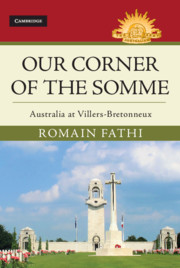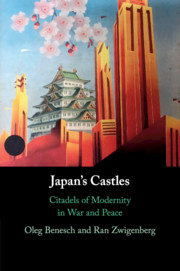Refine search
Actions for selected content:
15418 results in Military history
8 - Japan’s New Castle Builders
- from Part II - From Feudalism to the Edge of Space
-
- Book:
- Japan's Castles
- Published online:
- 15 April 2019
- Print publication:
- 02 May 2019, pp 294-320
-
- Chapter
- Export citation
Conclusions
- from Part II - From Feudalism to the Edge of Space
-
- Book:
- Japan's Castles
- Published online:
- 15 April 2019
- Print publication:
- 02 May 2019, pp 321-330
-
- Chapter
- Export citation
Bibliography
-
- Book:
- Japan's Castles
- Published online:
- 15 April 2019
- Print publication:
- 02 May 2019, pp 331-350
-
- Chapter
- Export citation
Introduction
-
- Book:
- Japan's Castles
- Published online:
- 15 April 2019
- Print publication:
- 02 May 2019, pp 1-14
-
- Chapter
- Export citation
5 - Castles in War and Peace II
- from Part II - From Feudalism to the Edge of Space
-
- Book:
- Japan's Castles
- Published online:
- 15 April 2019
- Print publication:
- 02 May 2019, pp 185-227
-
- Chapter
- Export citation

Our Corner of the Somme
- Australia at Villers-Bretonneux
-
- Published online:
- 16 April 2019
- Print publication:
- 07 February 2019

Japan's Castles
- Citadels of Modernity in War and Peace
-
- Published online:
- 15 April 2019
- Print publication:
- 02 May 2019
Acknowledgments
-
- Book:
- George Rochberg, American Composer
- Published by:
- Boydell & Brewer
- Published online:
- 21 May 2021
- Print publication:
- 15 April 2019, pp xi-xii
-
- Chapter
- Export citation
5 - A Moral Education for the Future: 1948–2005
-
- Book:
- George Rochberg, American Composer
- Published by:
- Boydell & Brewer
- Published online:
- 21 May 2021
- Print publication:
- 15 April 2019, pp 120-147
-
- Chapter
- Export citation
List of Illustrations
-
- Book:
- George Rochberg, American Composer
- Published by:
- Boydell & Brewer
- Published online:
- 21 May 2021
- Print publication:
- 15 April 2019, pp ix-x
-
- Chapter
- Export citation
Index of George Rochberg’s Musical Compositions
-
- Book:
- George Rochberg, American Composer
- Published by:
- Boydell & Brewer
- Published online:
- 21 May 2021
- Print publication:
- 15 April 2019, pp 225-226
-
- Chapter
- Export citation
Afterword: On Trauma, Moral Injuries, and Aesthetic Recoveries
-
- Book:
- George Rochberg, American Composer
- Published by:
- Boydell & Brewer
- Published online:
- 21 May 2021
- Print publication:
- 15 April 2019, pp 148-162
-
- Chapter
- Export citation
1 - Second Lieutenant Aaron G. Rochberg: 1938–48
-
- Book:
- George Rochberg, American Composer
- Published by:
- Boydell & Brewer
- Published online:
- 21 May 2021
- Print publication:
- 15 April 2019, pp 8-42
-
- Chapter
- Export citation
Notes
-
- Book:
- George Rochberg, American Composer
- Published by:
- Boydell & Brewer
- Published online:
- 21 May 2021
- Print publication:
- 15 April 2019, pp 163-212
-
- Chapter
- Export citation
Frontmatter
-
- Book:
- George Rochberg, American Composer
- Published by:
- Boydell & Brewer
- Published online:
- 21 May 2021
- Print publication:
- 15 April 2019, pp i-iv
-
- Chapter
- Export citation
4 - Jewish Secularism as Ars Combinatoria: 1954–87
-
- Book:
- George Rochberg, American Composer
- Published by:
- Boydell & Brewer
- Published online:
- 21 May 2021
- Print publication:
- 15 April 2019, pp 100-119
-
- Chapter
- Export citation
Bibliography
-
- Book:
- George Rochberg, American Composer
- Published by:
- Boydell & Brewer
- Published online:
- 21 May 2021
- Print publication:
- 15 April 2019, pp 213-224
-
- Chapter
- Export citation
List of Abbreviations
-
- Book:
- George Rochberg, American Composer
- Published by:
- Boydell & Brewer
- Published online:
- 21 May 2021
- Print publication:
- 15 April 2019, pp xiii-xiv
-
- Chapter
- Export citation
Introduction
-
- Book:
- George Rochberg, American Composer
- Published by:
- Boydell & Brewer
- Published online:
- 21 May 2021
- Print publication:
- 15 April 2019, pp 1-7
-
- Chapter
- Export citation
Dedication
-
- Book:
- George Rochberg, American Composer
- Published by:
- Boydell & Brewer
- Published online:
- 21 May 2021
- Print publication:
- 15 April 2019, pp v-vi
-
- Chapter
- Export citation
